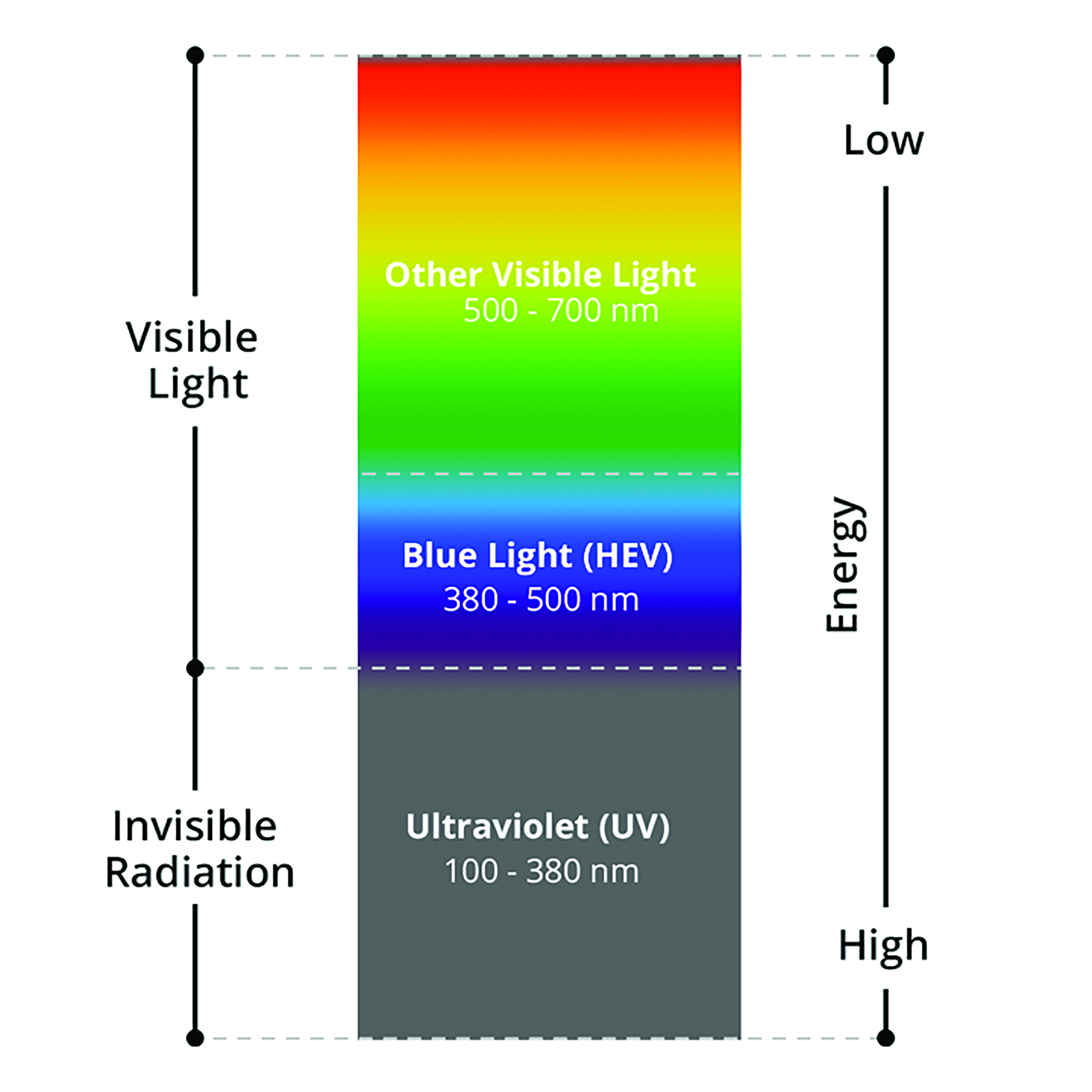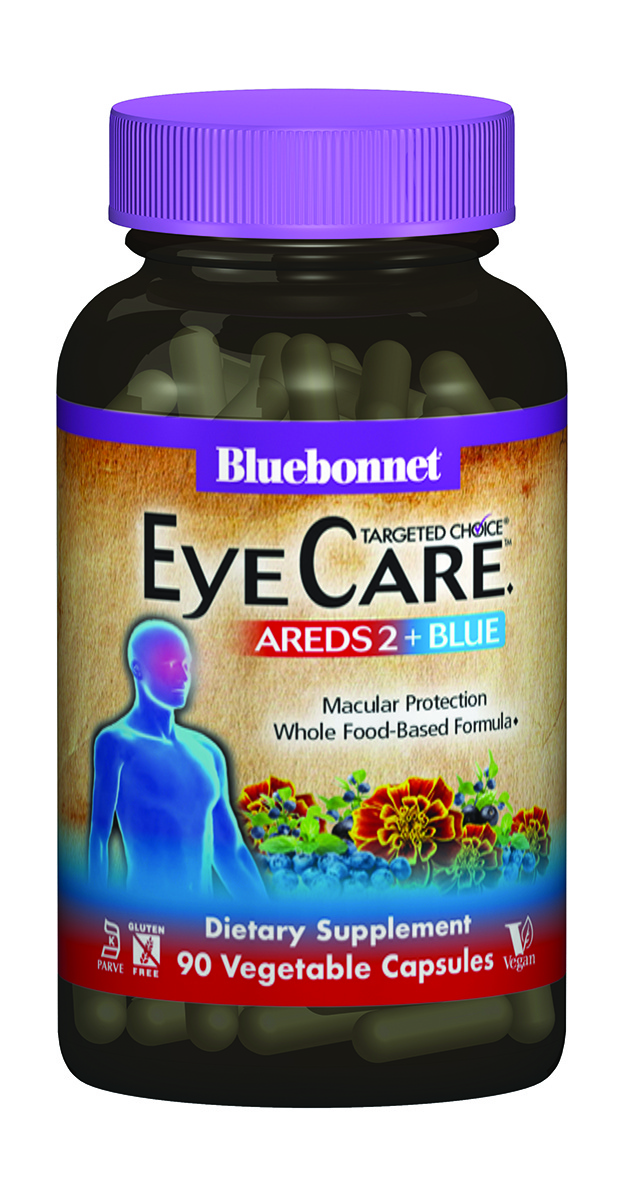 Blue light is part of a light spectrum that is visible to the human eye and provides basic illumination and can also enhance feelings of wellbeing. Light is made up of electromagnetic particles that travel in waves. These waves emit energy and range in length and strength. The shorter the wavelength; the higher the energy. Every wavelength is represented by a different color and is grouped into the following categories: gamma rays, x-rays,
ultraviolet (UV) rays, visible light, infrared light, and radio waves. Together, these wavelengths make up the electromagnetic spectrum.
Visible light is the part that is seen as colors: violet, indigo, blue, green, yellow, orange and red. Blue light has a very short wavelength, and so it produces a higher amount of energy. Long-term exposure to the blue end of the light spectrum could cause serious long-term damage to your eyes because it penetrates all the way to the retina, damaging light-sensitive cells. This causes changes that resemble those of macular degeneration, which can lead to permanent vision loss.
Blue light is part of a light spectrum that is visible to the human eye and provides basic illumination and can also enhance feelings of wellbeing. Light is made up of electromagnetic particles that travel in waves. These waves emit energy and range in length and strength. The shorter the wavelength; the higher the energy. Every wavelength is represented by a different color and is grouped into the following categories: gamma rays, x-rays,
ultraviolet (UV) rays, visible light, infrared light, and radio waves. Together, these wavelengths make up the electromagnetic spectrum.
Visible light is the part that is seen as colors: violet, indigo, blue, green, yellow, orange and red. Blue light has a very short wavelength, and so it produces a higher amount of energy. Long-term exposure to the blue end of the light spectrum could cause serious long-term damage to your eyes because it penetrates all the way to the retina, damaging light-sensitive cells. This causes changes that resemble those of macular degeneration, which can lead to permanent vision loss.Q2: What are the effects of blue light on children’s vision?A tablet, iPhone, video game or TV may be an easy distraction for children, but to young eyes, it can be a disturbance and even a danger. Consumers, particularly children and younger generations, are glued to high tech devices 24/7, and because of this, they are being constantly exposed to blue light. Blue light has a very short wavelength, so it produces a higher amount of energy. As mentioned above, long-term exposure to the blue end of the light spectrum could cause serious long-term injury to the eyes since it penetrates all the way to the retina, damaging light-sensitive cells. This continual exposure to blue light over time is concerning many researchers who believe that the growth rate of age-related eye diseases like macular degeneration will exponentially increase over the next few generations unless consumers do more to protect their eyes early during adolescence by wearing sunglasses, turning on blue light filters on their high tech devices, having regular eye exams, and taking eye care supplements like Targeted Choice® EyeCare AREDS 2 + BLUE Vegetable Capsules that can help shield the macula from excessive blue light.
 Q3. When choosing a dietary supplement to protect my eyes, what should I look for?
Q3. When choosing a dietary supplement to protect my eyes, what should I look for? The Age-Related Eye Disease Studies (AREDS) were sponsored by the Federal Government’s National Eye Institute, which falls under National Institutes of Health (NIH). These studies found that taking high levels of antioxidants and zinc can reduce the risk of developing advanced age-related macular degeneration (AMD) by about 25 percent. So, to address the clinically studied nutrients recommended by the National Eye Institute based on the AREDS 2 study, the nutritional scientists at Bluebonnet introduced Targeted Choice EyeCare™ Vegetable Capsules that are specially formulated with:
• 500 mg of vitamin C
• 200 IU of vitamin E
• 40 mg zinc as zinc gluconate
• 2 mg copper as copper gluconate
• 10 mg lutein and 2 mg zeaxanthin
In addition, hyaluronic acid and sustainably harvested or wildcrafted super fruits (e.g., bilberry and wild blueberry) were integrated to help protect eyes from the growing concern surrounding blue light (e.g., LED). This formula was developed to not only provide the necessary AREDS ingredients but also to deliver additional eye nutrients shown in research to help further shield the eyes from the photo stress of the 21st Century caused by blue light emitted from high tech devices that consumers use every day.
The Age-Related Eye Disease Studies (AREDS) were sponsored by the Federal Government’s National Eye Institute, which falls under National Institutes of Health (NIH). These studies found that taking high levels of antioxidants and zinc can reduce the risk of developing advanced age-related macular degeneration (AMD) by about 25 percent. So, to address the clinically studied nutrients recommended by the National Eye Institute based on the AREDS 2 study, the nutritional scientists at Bluebonnet introduced Targeted Choice EyeCare™ Vegetable Capsules that are specially formulated with:
• 500 mg of vitamin C
• 200 IU of vitamin E
• 40 mg zinc as zinc gluconate
• 2 mg copper as copper gluconate
• 10 mg lutein and 2 mg zeaxanthin
In addition, hyaluronic acid and sustainably harvested or wildcrafted super fruits (e.g., bilberry and wild blueberry) were integrated to help protect eyes from the growing concern surrounding blue light (e.g., LED). This formula was developed to not only provide the necessary AREDS ingredients but also to deliver additional eye nutrients shown in research to help further shield the eyes from the photo stress of the 21st Century caused by blue light emitted from high tech devices that consumers use every day. Trisha Sugarek MacDonald holds a Master of Science in Nutrition from Texas Woman’s University and also a Bachelor of Science Degree in Nutrition and Foods from Texas State University. Mrs. MacDonald is currently the Sr. Director of Research & Development as well as the National Educator at Bluebonnet Nutrition where she investigates new ingredients, directs the launch of new products, and provides industry training on numerous subjects as it relates to the connection between nutrition and health. She is a frequent editorial contributor and lecturer on the benefits surrounding the responsible use of supplements.
Trisha Sugarek MacDonald holds a Master of Science in Nutrition from Texas Woman’s University and also a Bachelor of Science Degree in Nutrition and Foods from Texas State University. Mrs. MacDonald is currently the Sr. Director of Research & Development as well as the National Educator at Bluebonnet Nutrition where she investigates new ingredients, directs the launch of new products, and provides industry training on numerous subjects as it relates to the connection between nutrition and health. She is a frequent editorial contributor and lecturer on the benefits surrounding the responsible use of supplements.Resources:1. ARVO 2017, Yu et al. L/Zi protect photoreceptors against blue light-induced degeneration (in vivo) Functional Foods Conference, 2016, Yu et al L/Zi ameliorate photoreceptor degeneration (in vivo) 2. ARVO 2017 Juturu et al. L/Zi modulates Photo-Oxidative Retinal Damage (in vivo) 3. B.L.U.E. (20mg) (MPOD, Vis, Phys, submitted) 4. Hammond BR, Johnson MA. The age-related eye disease study (AERDS). Nutrition Reviews. 2002; 60(9): 283-288. 5. National Institutes of Health. National Eye Institute. Facts About Age-Related Macular Degeneration. https://nei.nih.gov/health/maculardegen/armd_facts









